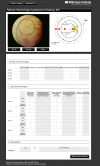Retinal hemorrhage in abusive head trauma: finding a common language
- PMID: 25075150
- PMCID: PMC4102172
Retinal hemorrhage in abusive head trauma: finding a common language
Abstract
Purpose: To assess the performance of a refined Web-based tool for documenting retinal hemorrhage characteristics in suspected abusive head trauma.
Methods: Using a comprehensive tabular secure platform, with access to digital images in color, black and white, and 4-zone system schematic overlay, four pediatric ophthalmologists performed pilot testing with 80 images for tool refinement. In a second phase, retinal hemorrhages were documented by number, zone, and type. Interobserver agreement was calculated using the Fleiss kappa coefficient. Intraobserver agreement was calculated using Cohen's kappa statistic. We used surface area mapping software for further analysis.
Results: Interobserver agreement was good (kappa 0.4-0.6) and very good (kappa 0.6-0.8) for all questions in Zone A (peripapillary). For zones C (midperiphery) and D (peripheral retina), agreement was very good for all questions except number of hemorrhages, for which agreement was good. Zone B (macula) showed good and fair agreement except for superficial hemorrhage, for which agreement was poor. There was very good intraobserver agreement for number (kappa 0.68, 0.65, 0.67) and type of hemorrhages in zones A, B, and C. Surface area mapping results revealed no significant differences between zones A and B. Zones C and D had significantly less hemorrhage than A and B.
Conclusions: Our tool performed with good or very good interobserver and intraobserver agreement in almost all domains. We attribute zone B underperformance to the significant increased area covered by hemorrhages compared to zones C and D and the lack of contrast with normal anatomical structures in zone A.
Figures



References
-
- Christian CW, Block R, Committee on Child Abuse and Neglect Abusive head trauma in infants and children. Pediatrics. 2009;123(5):1409–1411. - PubMed
-
- Kivlin J, Simons K, Lazoritz S, Ruttum M. Shaken baby syndrome. Ophthalmology. 2000;107(7):1246–1254. - PubMed
-
- Morad Y, Kim Y, Armstrong D, Huyer D, Mian M, Levin A. Correlation between retinal abnormalities and intracranial abnormalities in the shaken baby syndrome. Am J Ophthalmol. 2002;134:354–359. - PubMed
-
- Levin AV. Retinal hemorrhage in abusive head trauma. Pediatrics. 2010;126(5):961–970. - PubMed
-
- Greenwald M, Weiss A, Oesterle C, Friendly D. Traumatic retinoschisis in battered babies. Ophthalmology. 1986;93:618–625. - PubMed
Publication types
MeSH terms
LinkOut - more resources
Full Text Sources
Medical
